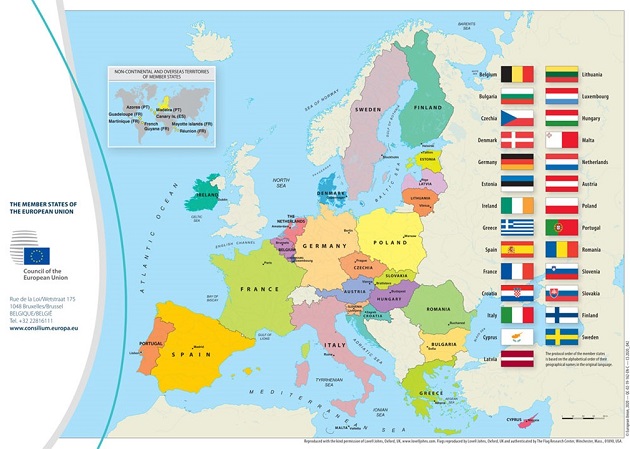About the European Union

The European Union traces its origins to a 1951 cooperation agreement among six countries (Belgium, Germany, France, Italy, Luxembourg, and the Netherlands); now, some fifty years later, the EU has 27 member states (having added Denmark, Ireland, the United Kingdom*, Greece, Spain, Portugal, Austria, Finland, Sweden, Latvia, Lithuania, Estonia, Poland, Hungary, the Czech Republic, Slovakia, Slovenia, Cyprus, Malta, Romania, Bulgaria, and from July 1st, 2013 Croatia). Enlargement of the EU to still other countries is contemplated.
On 1 February 2020, the United Kingdom left the EU.
 |
| Visit our EU map to learn more about each of the 27 countries in the European Union |
The goals of the European Union is to:
- promote economic and social progress;
- assert the identity of the EU on the international scene;
- strive toward a European citizenship;
- develop an area of freedom, security, and justice;
- and to maintain and build on established EU law.
The European Union, operates through five institutions:
- the European Parliament (elected by the peoples of the member states);
- the Council (which represents the governments of the member states);
- the European Commission (which is the executive body);
- the Court of Justice (which ensures compliance with the law);
- and the Court of Auditors (responsible for auditing accounts).
These institutions are supported by other bodies, including the Economic and Social Committee, the Committee of the Regions, the European Investment Bank, the European Central Bank, and the European Ombudsman (which deals with complaints from citizens). Additional information on the background of the European Union may be found at http://europa.eu/index_en.htm and through the European Union Studies Association.
 On January 1, 2002, the European Union introduced a new currency, the euro, in 12 of its member states. Of the 27 EU Member States today, nineteen have adopted the euro (Austria, Belgium, Cyprus, Estonia, Finland, France, Germany, Greece, Ireland, Italy, Latvia, Lithuania, Luxembourg, Malta, The Netherlands, Portugal, Slovakia, Slovenia, Spain). On January 1st, 2023, Croatia will adopt the euro. For more information on the euro, please see https:/www.ecb.europa.eueuro/html/index.en.html
On January 1, 2002, the European Union introduced a new currency, the euro, in 12 of its member states. Of the 27 EU Member States today, nineteen have adopted the euro (Austria, Belgium, Cyprus, Estonia, Finland, France, Germany, Greece, Ireland, Italy, Latvia, Lithuania, Luxembourg, Malta, The Netherlands, Portugal, Slovakia, Slovenia, Spain). On January 1st, 2023, Croatia will adopt the euro. For more information on the euro, please see https:/www.ecb.europa.eueuro/html/index.en.html
